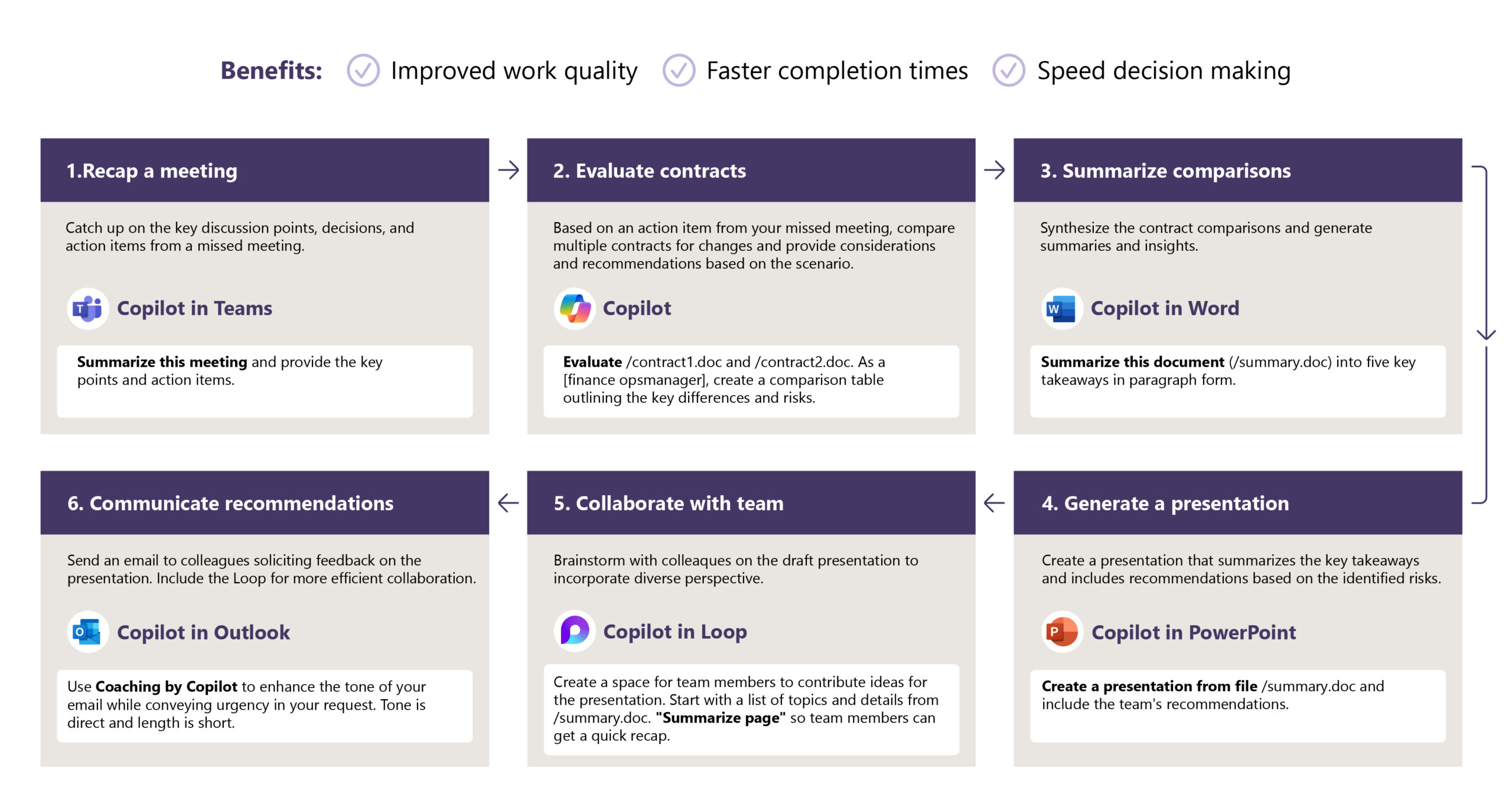There’s no question: Microsoft 365 Copilot is changing how work gets done here at Microsoft and beyond. An intelligent digital assistant with access to any company data you need that can process and accomplish requests using natural language—that’s a powerful productivity booster.
But how do you zero in on the scenarios and use cases that matter most to individual employees?
At Microsoft Digital, our company’s IT organization, we’re helping our employees get the most value out of this powerful new tool by identifying the roles where AI assistance can drive the most upfront impact, then developing hero scenarios to help them start using Copilot. The result is our Microsoft 365 Copilot Hero Scenario Playbook, a functional framework that helps teams discover ways that specific roles can adopt Copilot into their work and drive value.
When we started rolling Microsoft 365 Copilot out across the company, our priority in Microsoft Digital was giving as many employees as possible the chance to explore this exciting new tool. In a sense, we gave everyone the keys to the car and invited them to drive AI’s open road.
It resulted in a lot of exploration, increased usage, and some very eager early adopters. To help as many people get up to speed with Copilot as possible, we focused our initial adoption efforts on a common professional persona: the modern information worker.
“This is the beginning of an entirely new meta-skill,” says Don Campbell, a senior director on Microsoft Digital’s Employee Experience Success team. “People are thinking through new habits and ways of working as they learn what Copilot is capable of enabling.”
Because of the excitement around AI, uptake was rapid and enthusiastic. Our next step was building on that initial surge of adoption and experimentation to drive more profound, targeted impact.
Actioning inspiration: Building a pathway to hero scenarios

As Microsoft 365 Copilot usage began to mature across the company, we saw opportunities to build on this momentum by presenting more contextual applications for AI. Within Microsoft Digital, we decided to create a standardized process for defining Copilot hero scenarios in roles where initial applications of AI could have the greatest impact. Concrete scenarios would resonate with those professionals by addressing real-world challenges they face every day, saving them time and bandwidth.
Ultimately, we had one goal: accelerating time to value for Copilot users.
“We wanted to explore how we could make Copilot more real to the individual,” Campbell says. “They’re asking how they can use this in ways that are specific to their role, in their function, in their organization.”
We identified five main objectives to help us get there:
- Understand the top responsibilities, challenges, needs, and wants of priority roles.
- Articulate and communicate hero scenarios for those roles and depict ways for Copilot to enable their work.
- Outline blockers and accelerators for Copilot adoption and hero scenarios.
- Generate feedback for product groups to improve Copilot.
- Share playbook outputs with our product marketing group and post them in our Copilot Lab, our publicly available repository of Copilot prompts, to contribute value to external users.
“From the beginning, we set out to articulate our objectives and our deliverables, then worked back from there,” says Heather Layne, a director of program management on the Employee Experience Success team in Microsoft Digital. “When it came to research, we relied on our EX Studio for step-by-step guidance on purposeful engagement.”
That process unfolded in a layered approach. First, we identified the Microsoft organizations that were best positioned to receive our support. Thanks to strong interest and a robust cohort of early adopters, sales, HR, and finance were excellent candidates for our first efforts.
From there, we worked with stakeholders and AI adoption teams within each of those organizations to prioritize roles according to a rubric of criteria. Those criteria focused on enthusiasm for adoption, readiness for the next level of engagement, the number of people represented by that role within their organization, and Copilot’s applicability for their work—especially for repetitive, context-rich, or communication-intensive tasks.

“In HR, for example, we ensured there was complete thinking regarding a reimagination of our business functional architecture,” says Christopher Fernandez, corporate vice president in HR. “We identified key roles and corresponding workflows that could directly benefit from Microsoft 365 Copilot by removing mundane and repetitive tasks and providing insight to creative solutions needed to deliver business value.”
After we identified those roles, we moved into focus-group sessions with 10 to 20 participants, all selected because they had been actively using Copilot and could provide practical ideas and suggestions. It was an opportunity to tap into willing talent and let our leaders lead.
The output of those sessions came down to three hero scenarios per role, each with six steps and six Copilot prompts to propel those processes forward, as well as the relevant Microsoft tools where the prompts would apply. We also ensure these scenarios align with the company’s Responsible AI principles.
For example, our Finance team identified operations manager as a priority role. One of its key scenarios included managing contracts, and it demonstrates how prompts come together across several apps to create a process bolstered and streamlined by automation.
Finance operations | Contract management

“That output then served as an input in a few different places,” Campbell says. “We evangelized it out to the organization itself to help drive ideation, adoption, and usage, to our product marketing group for customer scenarios, and to our Copilot Lab to provide freely available examples of prompts.”
As a result, we’ve been able to boost Copilot adoption and usage across Microsoft, providing specific, concrete opportunities for people to apply this new way of working to their roles.
Crafting your own Microsoft 365 Copilot hero scenarios
This process has the benefit of being structurally simple, modular, and repeatable—so much so that we’ve made it freely available to any organization that’s using Microsoft 365 Copilot in the form of our Microsoft 365 Copilot Hero Scenario Playbook. Whether you’re adopting Copilot across your entire organization, a department, a business group, or a team, we strongly encourage you to work through this exercise.
“We want organizations to know that there are opportunities to keep this process controlled and standardized,” Layne says. “By aligning with rubrics and setting up standard practices, you know you’re not just putting in time to create something that isn’t helpful or impactful.”
Our playbook walks adoption leaders through a four-stage process that includes readiness, engagement, delivering an output, and sharing results with employees. To accelerate time to value, we’ve designed the process implementation across three weeks.
Microsoft 365 Copilot Hero Scenario Playbook


By following the playbook through four phases, you can accomplish what we’ve done at Microsoft: understanding what your priority roles need to be successful, articulating hero scenarios tailored to their work, and sharing the outputs with your organization to accelerate time to value for Copilot users.
Phase 1: Ready
This phase will help your organization, department, or team prepare for the process. It involves aligning with leadership and sponsors who will be accountable for driving Copilot value within their organization. It’s also where you’ll select the priority roles, draft outlines of those roles so you can clarify your understanding of their needs and wants, and seek out feedback from leaders, managers, and subject matter experts.
Phase 2: Engage
Engaging with employees delivers the core value of this exercise. In the engagement phase, you’ll identify participants from your priority roles who demonstrate enthusiasm and early aptitude with Copilot. From there, you choose an engagement approach that might include in-person group sessions, virtual Microsoft Whiteboard sessions, one-on-one interviews, Microsoft 365 Loop collaboration, or whatever modality works best, then communicate the process to participants and conduct your engagement.
Phase 3: Deliver
Ideating hero scenarios is how you discover value. The delivery phase defines that value and organizes it into a useful, consumable format. It starts with reviewing and analyzing the outcomes of your sessions to gain insights and identify themes. Now is the time to document your hero scenarios and the value they add, as well as blockers and accelerators. Finally, you’ll provide your output: a comprehensive deck that includes your priority roles, hero scenarios, next steps, and more.
Phase 4: Share
The final phase of this process involves socializing your scenarios across your team or organization to realize value. If you’re part of a large organization, it’s helpful to radiate these outputs beyond the target group as an opportunity for further Copilot momentum. This stage includes diving deeper into blockers and accelerators that can help your organization as a whole speed time to value.
“So much of adoption comes down to the question of ‘What’s in it for me?’” says Liz Friedman, a senior director of HR AI Transformation. “The ability to answer that question at the role level, at the level of fidelity that really resonates with what employees actually do, creates a strong bridge between the realm of possibility and day-to-day reality.”
Capturing the limitless value of AI

The shift to AI is about more than productivity. It’s about new ways of working and new ways of being.
Thanks to the modular nature of this framework, teams across Microsoft can now apply this process to their own professional needs. As time goes on, the goal is for different organizations and roles to uncover robust and efficient ways of working.
“With Copilot, we’re building new skillsets, but also new habits,” says Nathalie D’Hers, corporate vice president of Microsoft Digital. “That takes experimentation and learning, but the payoff is transformative.”
By learning from our experience and working through the Microsoft 365 Copilot Hero Scenario Playbook, your organization can execute best practices that will make the most of your AI investment, deliver value faster, manage change effectively, and scale across your organization.
Access the Microsoft 365 Copilot Hero Scenario Playbook here.

Here are some tips for getting started with developing persona-specific scenarios for priority roles at your company:
- Build strong organizational partnerships and add this process into AI efforts that teams already have underway. Identify the key AI leaders and champions on those teams.
- This process is additive and iterative, so don’t be married to the playbook. Start with the framework, then allow it to grow around organic efforts.
- Frame your scenarios around business processes, then layer on the technology.
- Validate your results through active communication, especially after you’ve socialized your hero scenarios. That ensures you sort the signal from the noise and capture even greater value moving forward.
- For your working groups, make sure you choose teams and people who have good engagement with the tool, especially enthusiasts and early adopters. This also gives people the chance to learn from each other and build on their colleagues’ ideas.
- Have a game plan about where to go next in terms of sharing and piloting. Include follow-ups and baselines so these outputs don’t just sit on the shelf.
- Get multiple perspectives. No role is exactly the same, even if the job title is. Bringing people who do similar work together and hearing commonalities and differences is very helpful and provides an opportunity to benefit from a diversity of perspectives.

New to Microsoft 365 Copilot? Get started today and see what’s possible.






